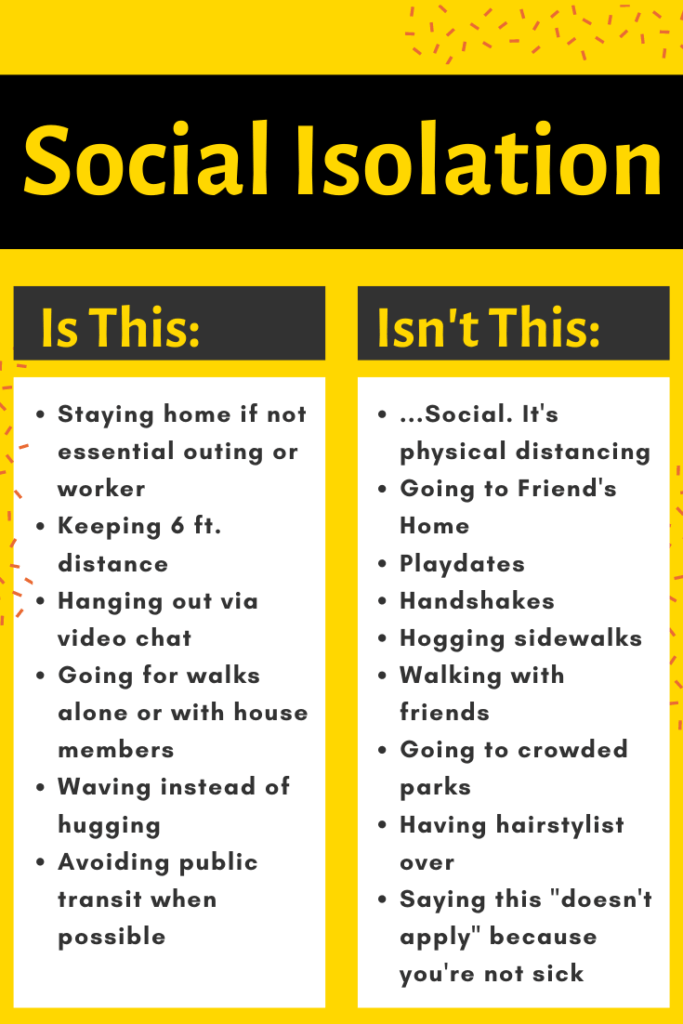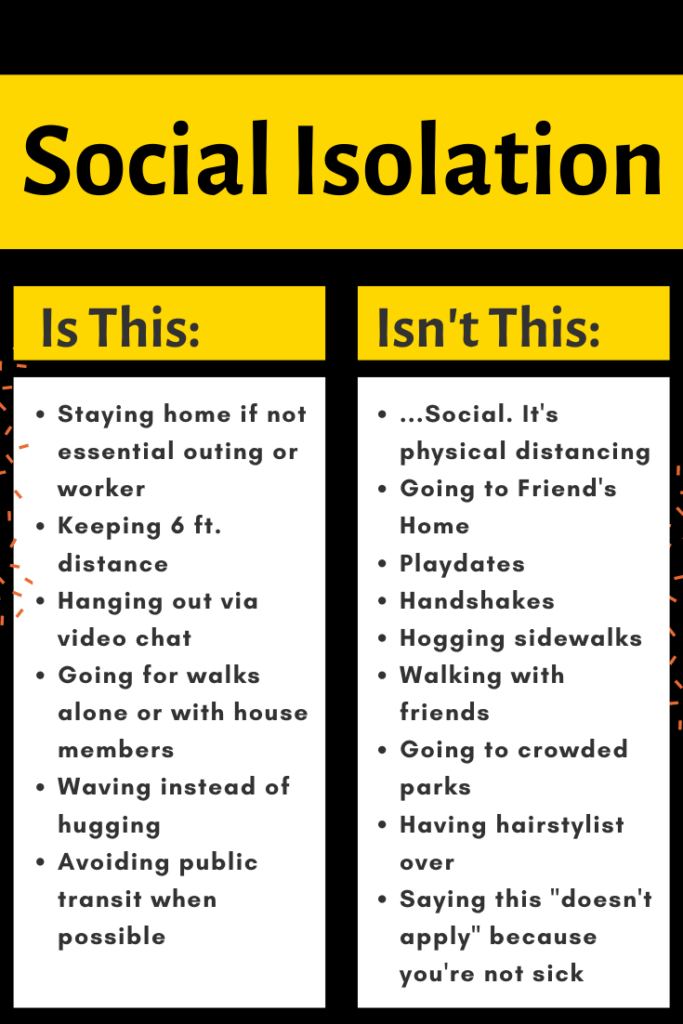
Table of Contents
Social distancing is a new term and with that, there seems to be some confusion.
Social distancing would be better off termed “physically distancing.”
Technically, we can still find ways to be social. It’s being physically close to people outside our homes that we need to avoid.
Since this is a very weird and new time, some people have trouble figuring out what physical distancing means in their daily lives.
Based on many countries’ government guidelines right now, here’s shortest answer to that: If your work is non-essential, stay home unless you need necessities. When you go for necessities or a walk, keep 6 feet between you and other people.
This list is a more detailed breakdown of that definition. It basically states the same thing in 100 different ways. Sorry for the redundancy, but feel free to send this list to anyone who argues about what social distancing is. If you have anything to add to this list, email me.
FYI: The Differences & Where You Fit
Confused about what you need to do? If a healthcare professional hasn’t given you specific instructions, this lays it out pretty clearly.
#1 Social Distancing
Social distancing is recommended for every non-sick citizen by the Canadian Government and the Centers for Disease Control and Prevention (CDC) in the U.S. (state recommendations and laws vary). We’ve detailed exactly what that means in this post. For starters, it’s a public health practice meant to control the spread of a disease. Its effectiveness is scientifically-backed.
#2 Self-Isolation
For you if you have no symptoms of COVID-19 and you’ve travelled outside of your country in the last 14 days OR you’ve come into contact with someone who has COVID-19, or you’ve been told to by a health authority. Self isolation means to stay at home and monitor yourself for symptoms for 14 days. You should avoid contact with others. If you have NO symptoms but you’ve been exposed to someone with COVID-19, you can still go outside for a walk. If you’re thinking “this sounds a lot like social distancing,” yeah, it does. That’s because we don’t really know who has and hasn’t been infected at this point. Since symptoms can take weeks to show, few of us can be sure.
#3 Isolate/Quarantine
For you if you have COVID-19 symptoms or if you’ve been diagnosed for COVID-19 or if you’re awaiting results or if you’ve been advised to do so by a health authority. This means to stay at home and avoid contact with others, including other family members. If you know you have COVID-19, make every effort possible to physically avoid those you live with and to avoid transferring germs. More severe symptoms may have you quarantined in a hospital. If you live with someone who is elderly or immune compromised, you may be quarantined outside of your home.
To be clear, most of us fit into the social distancing category. Social distancing is an extreme measure. It does suck. But it is scientifically effective. And it doesn’t last forever, if we listen.
Social Distancing Is This:
- Staying at home if your work is non-essential
- Working from home, if you can
- Only leaving your home for essentials (ex. groceries, medication, doctor’s appointments)
- Only using public transit if you have to
- If you do use public transit, keep space when possible. Don’t sit or stand next to someone if you don’t have to.
- Standing 6 feet between you and others when you go for walks
- Waving instead of hugging
- Cancelling, postponing or rescheduling plans or events
- Hanging out with friends… VIA VIDEO CHAT
- Calling to check-in on people, especially those most vulnerable
- Netflix & chill with Netflix Party only (I know, a lot less exciting, sorry)
- Having meetings over Zoom or GoToMeeting (or any other similar site)
- Going for walks with those you live with (and only those you live with)
- Going to the park, realizing there’s too many people and leaving (sorry)
- Especially avoiding older people (but really, everyone outside of your home)
- Keeping 6 feet behind someone in line
- Dropping off groceries/supplies outside of someone’s home
- Washing your hands before and after leaving your home
- Making less grocery store trips (buy enough for about a week, a U.S. expert says)
- Finding alternatives to non-essential doctor’s appointments (webcam, call, etc.)
- If someone in your home can’t physically distance, avoiding sharing a toothbrush, kissing, hugging, sexual contact, etc. (sorry).
Social Distancing Isn’t:
- …Isn’t really social distancing. It’s more like physical distancing.
- Inviting friends over (sorry, it sucks, but your lay off isn’t a vacation)
- Going to a friend’s home
- Throwing a quarantine party (if you’re considering it, this is the definition of quarantine…)
- Inviting your ex over because you’re lonely (good advice even if social distancing wasn’t a thing)
- Letting your kids congregate with other kids in the park
- Having playdates with your kid’s friends
- Non-essential travel (again, this is not a vacation, sorry)
- Going for a walk with your 10 closest friends (or anyone outside your home)
- Having a picnic with other families
- Playing games with your friend outside
- Hoarding (you can still go grocery shopping, no need to hoard)
- Getting into a fist fight over the last toilet paper roll (hard to punch someone when you’re supposed to be 6 feet away)
- Taking over an entire sidewalk with your family when going out for walks (this makes 6 feet distancing near impossible)
- Sticking around when you realize the park is full of people and you can’t distance
- Handshaking
- Going to the dog park (sorry, pups!)
- Having your hairstylist or nail technician over to fix you up (really! Who’s going to see you? You should be at home!)
- Standing directly behind someone in line (or less than 6 feet)
- Saying “this doesn’t apply to me because I’m not sick” (here’s the problem: symptoms may not show for weeks, meaning that very few actually know they’re actually not sick)
- Hanging around public places (get in, get what you need and get out!)
What is 6 Feet?
- 2 arms-length (baby arms don’t count)
- 2 meters
- 72 inches
- 183 cm.
- 6 standard-size rulers
- The width of an average car
- 6 foot-long Subway sandwiches
- How does 6ft. compare to your height? Use that as a reference. Imagine yourself laying down on the street, would you touch them? For example, I’m 5’2, so I know me lying down plus a foot is enough space.
Please. Follow to the Recommendations. This Won’t Last Forever. But it will Last A Whole Lot Longer If You Don’t Listen.



